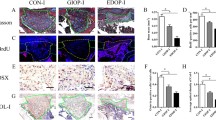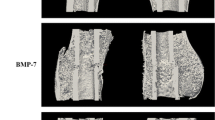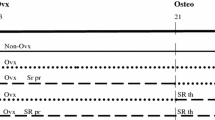Abstract
Although osteoporosis has been the subject of a considerable number of publications in recent years, very few studies have investigated the effects of osteopososis on the process of tissue repair. Most of the studies are based on animal data, using the ovariectomized rat model, and in most cases, fractures were obtained by femoral osteotomy. This model is imperfect in several aspects to fit with postmenopausal osteoporosis which is a complex, multifactorial disorder. Furthermore, a surgically induced fracture is not exactly the same as a fracture which occurs as a result of bone fragility. However, and despite contradictory results in some of the studies, in ovariectomized rats a delay in bone consolidation has been reported in the model, associated locally with a decrease in bone mineral density and mechanical resistance. Very few human data are available, which confirm the existence of a delay in consolidation subsequent to femoral fractures in aged patients compared to young patients.
Similar content being viewed by others
Avoid common mistakes on your manuscript.
Introduction
Although osteoporosis is a disease which, by definition, is characterized by an increase in bone fragility, it is generally admitted that there are no delays in the consolidation process in the course of the osteoporotic fractures. However, very few data are available, particularly in human beings. Most of the studies are based on animal models, with the well-known limitations of such models. The majority of the studies have been conducted in the ovariectomized rat model, which differs in many respects from what occurs in postmenopausal women. Finally, the data are sometimes contradictory.
Even less data are available in corticosteroid-induced osteoporosis, all of them being based on animal data.
An overview of the various elements involved in the process of post-fracture bone healing is presented in Fig. 1. These steps may be altered to various degrees during osteoporosis.
Postmenopausal osteoporosis
Animal data
Most of the work have been conducted in the ovariectomized rat model, and in the vast majority of cases, the fracture model employed was an osteotomy of the medial part of the femur [1–12].
Kubo et al. [1] conducted a study involving 60 female Wistar rats. The rats, aged 7 months at inclusion, were randomly assigned to two groups: an “ovariectomy + low-calcium diet” group and a sham-surgery control group. Six weeks after the ovariectomy, no significant differences were observed between the two groups when radiological, histological, and biomechanical data was compared. On the other hand, at 12 weeks, in the ovariectomized rats, a decrease in bone mineral density (BMD) was observed at the fracture site, as well as osteoporosis-type histological changes. In another study, Meyer et al. investigated a large cohort of Sprague–Dawley (SD) rats. Their model was comparable to that used in Kubo’s study, except that the ovariectomized group did not receive a low-calcium diet. The rats were also assigned to three groups on the basis of age of sacrifice. In the youngest rats (8 weeks), no significant differences were observed between the two groups when biomechanical properties at the fracture site were compared. In intermediate-age rats (31 weeks), 6 weeks after the start of the study, biomechanical parameters were comparable in both groups. On the other hand, among the rats sacrificed 12 weeks after the start of the study, a reduction in biomechanical parameters was observed in the ovariectomized rats. In the group of rats sacrificed 50 weeks after the start of the study, the authors observed biomechanical disorders at D + 24 weeks in both groups, with the disorders being more pronounced in the ovariectomized group. In a study involving a smaller and younger group of SD rats (34 rats aged 2 months at inclusion), Namkung et al. [3] observed a 40% reduction in fracture callus area in ovariectomized rats, as well as a 23% reduction in BMD. Moreover, severe disruptions in biomechanical parameters were observed, notably a fivefold decrease in the energy required to break the fracture callus, a threefold decrease in peak failure load, and a twofold decrease in stiffness. Again using an ovariectomized-rat model, Cao et al. assessed a large cohort of 3-month-old SD rats. The main purpose of that study was to assess the effects of various anti-osteoporosis treatments (estrogens, raloxifene, and alendronate) on bone consolidation. The rats were assigned to either a sham-surgery or an ovariectomy group. The findings of the study are inconsistent with previous findings since, 6 weeks after ovariectomy, the authors observed an increase in the size of the fracture callus in the sham-surgery group. Furthermore, biomechanical properties were similar across the two groups. At 16 weeks, in the ovariectomized group, the fracture callus was found to be smaller in size than at 6 weeks. However, there were no significant differences in biomechanical parameters between the sham-surgery and the ovariectomized groups. Lill et al. [4] conducted a study involving sheep (n = 14), in which quite a good model for postmenopausal osteoporosis can be produced. The osteotomy was performed on the tibia and not the femur, as in the other studies. In vivo, the authors observed a delay (D + 2 weeks) in the increase in bending stiffness at the fracture callus in osteoporotic sheep. Similarly, torsional stiffness was 33% lower on the osteotomy side than on the opposite side. Ex vivo data suggested a 20% decrease in bending stiffness in osteoporotic sheep. In the ovariectomized Wistar rat model, Xu et al. [5] investigated several growth factors. Like several other authors before them, they observed a reduction in bone density on the osteotomy side, but more importantly, 3–4 weeks after the fracture, they also observed a reduction in TGFβ expression in the vicinity of the bone trabeculae. Similarly, the soft callus was found to be smaller in the ovariectomized rats. On the other hand, no significant difference was observed between the two groups as far as BMP-2 and FGF expression was concerned. In a study involving a cohort of 40 young (3 months old) Wistar rats, Islam et al. [6] investigated the effects of mandibular osteotomy on the process of bone consolidation. They also employed an ovariectomized rat model associated with a low-calcium diet. In their ovariectomy group, the authors observed a prolongation in the chondral ossification phase, with an increase in the number of osteoclasts. They also observed—unlike the previous study—an increase in both BMP-2 and TNFα expression in the ovariectomy group. Lastly, the number of osteoblasts—and more generally, the number of cells—expressing TNFα was higher in ovariectomized rats. Wang et al. assessed several biomechanical parameters in 84, 4-month-old SD ovariectomized rats. Osteotomy was performed on the tibia, not the femur. The authors reported a reduction in BMD ranging between 12.8% and 18% at 6, 12, and 18 weeks after the osteotomy. Similarly, at the same post-surgery intervals, failure load had decreased in the ovariectomy group by 24.3%, 31.5%, 26.6%, and 28.8%, respectively. Where callus failure stress was concerned, the figures were 23.9%, 33.6%, 19.1%, and 24.9%, respectively. From a qualitative point of view, the authors observed a delay in the chondral ossification process in the ovariectomy group, as well as a higher number of osteoclasts around the bone trabeculae, which, moreover, were arranged in irregular fashion. Qiao et al. [8] carried out a number of qualitative assessments on the same model. The authors’ results confirmed earlier findings showing an increase in the number of osteoclasts at the surface of the bone trabeculae in the vicinity of the fracture callus. They also found that the trabeculae were thinner and interrupted in ovariectomized rats. The process worsened over time. Working with a cohort of 93 SD rats aged 3 months at the start of their study, and using a femoral osteotomy model, McCann et al. [10], 8 weeks after ovariectomy, observed a reduction in BMD, a slowing down in the tissue repair process, and changes in mechanical parameters, and particularly in stiffness. Melhus et al. [11] results contradict a number of previous findings, despite quite a similar experimental protocol. Their cohort comprised 72 Wistar rats, which were relatively young (10 weeks old) at inclusion. The fracture was induced in the tibial shaft, and not the femoral shaft. Except for femoral stiffness, which was lower on the fracture side in the ovariectomy group compared to the control group, the authors found no significant difference between the two groups when the mechanical properties of the fracture callus were compared. Lastly, Yingjie et al. [12] investigated a cohort of 96 ovariectomized SD rats aged 8 months at inclusion. Fractures were induced at the femoral site. The main interest of the study lies in the parameters assessed by the authors, which included an analysis of microarchitectural structure. Twelve weeks after ovariectomy was performed, the authors found that total callus, bony callus, and new-formed bone measurements were about 20% lower than in the control group. From an architectural point of view, connectivity at the fracture site was 46% lower in the ovariectomy group than in the control group. Lastly, and quite logically, changes in biomechanical parameters were also observed in the ovariectomy group: failure load, bending stiffness, lower binding stress, and energy at failure were, respectively, 17%, 15%, 20%, and 28% lower than in the control group.
Human data
In a recent study, Nikolaou et al. [13] reported on 66 patients with femoral fractures treated by intramedullary nailing. Patients with open fractures, pathological fractures, or multiple trauma were not included in the study. The following parameters were measured: canal bone ratio (CBR): the ratio between the endosteal and outer diameter of the bone. Theoretically, in osteoporosis, this ratio is greater than 0.49. Singh index was also determined; an index of less than 4 was considered an indicator of osteoporosis. Patients were examined at D0, D + 1 week, D + 4 weeks, D + 8 weeks, D + 12 weeks, D + 16 weeks, D + 20 weeks, and D + 24 weeks. The patients were divided into two groups according to their age. Group A comprised 29 patients aged over 65 years. In this group, Singh indexes were systematically lower than 4, and CBRs always less than 0.5. The 37 remaining patients (group B) were aged 18–40 years. Their Singh indexes were assessed at 5 or 6. CBRs were always less than 0.48. By definition, significant differences were observed between the two groups at inclusion. In addition to a significant difference in mean age—76.8 years in group A and 25.3 years in group B—there was also a significant difference in the male-to-female ratio (83% in group B, 19% in group A; p < 0.0001). On the other hand, there was no significant difference in Injury Severity Score between the two groups. As the authors had voluntarily excluded patients with pseudoarthrosis, bone consolidation was always observed at 32 weeks in both groups. On the other hand, a delay in consolidation was observed in 10/29 patients (34%) in group A, as opposed to 4/37 patients (11%) in group B (p = 0.03). Similarly, mean delay in consolidation was higher in group A than in group B, i.e., 19.4 weeks ± 5.9 versus 16.2 weeks ± 5.1 (p = 0.02). As a retrospective investigation, this study is marred by several sources of bias. For instance, no precise assessment was made of the osteoporotic nature of the fracture in the aged patients. Additionally, the limits of the Singh index are well known. Lastly, there were differences in characteristics between the two groups, both in terms of age or sex ratio. As such, it is difficult to conclude whether the observed results were due to the effects of age or osteoporosis. There is no comparative study of osteoporotic/non osteoporotic or young/elderly patients in the literature, and one must recognize that such study would be difficult to implement, precluding any definite conclusion on that topic.
Corticosteroid-induced osteoporosis
Of the few studies which have been reported, only one [14] is summarized thereafter, for methodological reasons. In that study, 18 New Zealand rabbits were investigated. Fractures were induced by bilateral ulnar osteotomy. Two months after osteotomy, a subcutaneous injection of prednisone or a placebo was administered over a 6-week period, at the end of which the animals were sacrificed. Bone consolidation had successfully occurred in three of the 20 rabbits (15%) which had received the prednisone, as opposed to 13/16 (81%) in the control group (p < 0.001). The mean size of the fracture callus at 6 weeks, assessed from an image of a lateral view, was markedly lower in the rabbits which had received prednisone: 8.9 mm ± 1.3 versus 14.3 mm ± 1.8 (p < 0.001). Lastly, a biomechanical study was also conducted, the results of which were consistent with the other findings: in the corticosteroid-treatment group, stiffness and energy were more than 50% and 60% lower respectively than in the placebo group (p < 0.001 and p = 0.005, respectively). Despite the paucity of studies in this domain, given the toxic effect of corticosteroids on bone, it seems logical that there should be a delay in fracture consolidation in corticosteroid-induced osteoporosis.
Conclusion
Despite the paucity of data on the subject, and the sometimes contradictory nature of the existing data, there are nevertheless more studies supporting the existence of a delay in consolidation in osteoporosis in animals than those that do not. The only human data of any consequence (despite the methodological limits of this study allows similar conclusions). In corticosteroid-induced osteoporosis one study suggests an expected delay in consolidation, given the toxic effects of corticosteroids on bone.
References
Kubo T, Shiga T, Hashimoto J, Yoshioka M, Honjo H, Urabe M et al (1999) Osteoporosis influences the late period of fracture healing in a rat model prepared by ovariectomy and low calcium diet. J Steroid Biochem Mol Biol 68:197–202
Meyer RA Jr, Tsahakis PJ, Martin DF (2001) Age and ovariectomy impair both the normalization of mechanical properties and the accretion of mineral by the fracture callus in rats. J Orthop Res 19:428–435
Namkung-Matthai H, Appleyard R, Jansen J et al (2001) Osteoporosis influences the early period of fracture healing in a rat osteoporotic model. Bone 28:80–86
Lill CA, Hesseln J, Schlegel U et al (2003) Biomechanical evaluation of healing in a non-critical defect in a large animal model of osteoporosis. J Orthop Res 21:836–842
Xu SW, Wang JW, Li W, Wang Y, Zhao GF (2004) Osteoporosis impairs fracture healing of tibia in a rat osteoporoticmodel. Zhonghua Yi Xue Za Zhi 84:1205–1209
Islam AA, Rasubala L, Yoshikawa H et al (2005) Healing of fractures in osteoporotic rat mandible shown by the expression of bone morphogenetic protein-2 and tumour necrosis factor-alpha. Br J Oral Maxillofac Surg 43:383–391
Wang JW, Li W, Xu SW et al (2005) Osteoporosis influences the middle and late periods of fracture healing in a rat osteoporotic model. Chin J Traumatol 8:111–116
Qiao L, Xu KH, Liu HW, Liu HQ (2005) Effects of ovariectomy on fracture heating in female rats. Sichuan Da Xue Xue Bao Yi Xue Ban 36:108–111
Cao Y, Mori S, Mashiba T, Westmore MS, Ma L, Sato M et al (2002) Raloxifene, estrogen, and alendronate affect the processes of fracture repair differently in ovariectomized rats. J Bone Miner Res 17:2237–2246
McCann RM, Colleary G, Geddis C, Clarke SA, Jordan GR, Dickson GR, Marsh D (2008) Effect of osteoporosis on bone mineral density and fracture repair in a rat femoral fracture model. J Orthop Res 26:384–393
Melhus G, Solberg LB, Dimmen S, Madsen JE, Nordsletten L, Reinholt FP (2007) Experimental osteoporosis induced by ovariectomy and vitamin D deficiency does not markedly affect fracture healing in rats. Acta Orthop 78(3):393–403
Yingjie H, Ge Z, Yisheng W, Ling Q, Hung WY, Kwoksu Li, Fuxing P (2007) Changes of microstructure and mineralized tissue in the middle and late phase of osteoporotic fracture healing in rats. Bone 41:631–638
Nikolaou VS, Efstathopoulos N, Kontakis G, Kanakaris NK, Giannoudis PV (2009) The influence of osteoporosis in femoral fracture healing time. Injury 40:663–668
Waters RV, Gamradt SC, Asnis P, Vickery BH, Avnur Z, Hill E, Bostrom M (2000) Systemic corticosteroids inhibit bone healing in a rabbit ulnar osteotomy model. Acta Orthop Scand 71:316–321
Acknowledgment
The publication of the proceedings of the 5th Bone Quality Seminar 2010 has been made possible through an educational grant from Servier.
Conflicts of interest
None.
Author information
Authors and Affiliations
Corresponding author
Rights and permissions
About this article
Cite this article
Cortet, B. Bone repair in osteoporotic bone: postmenopausal and cortisone-induced osteoporosis. Osteoporos Int 22, 2007–2010 (2011). https://doi.org/10.1007/s00198-011-1612-3
Published:
Issue Date:
DOI: https://doi.org/10.1007/s00198-011-1612-3





